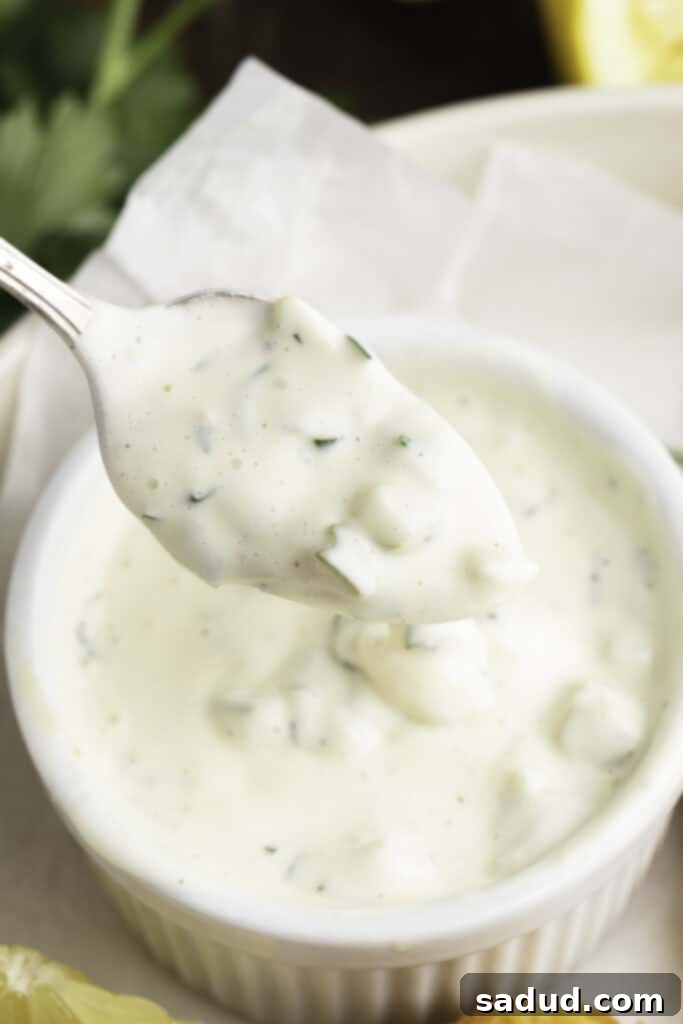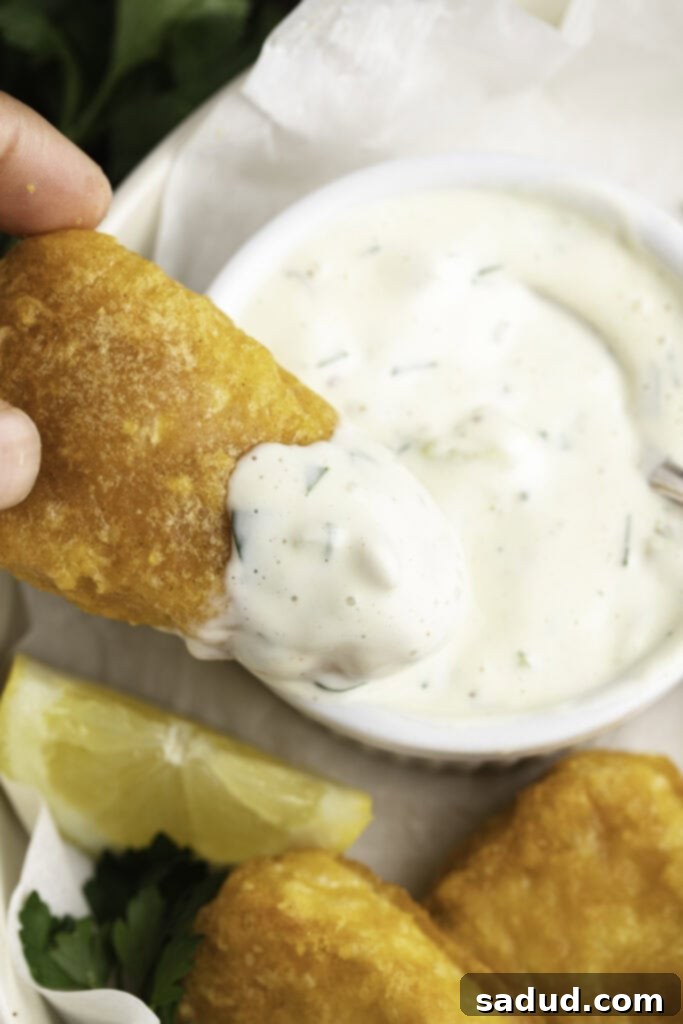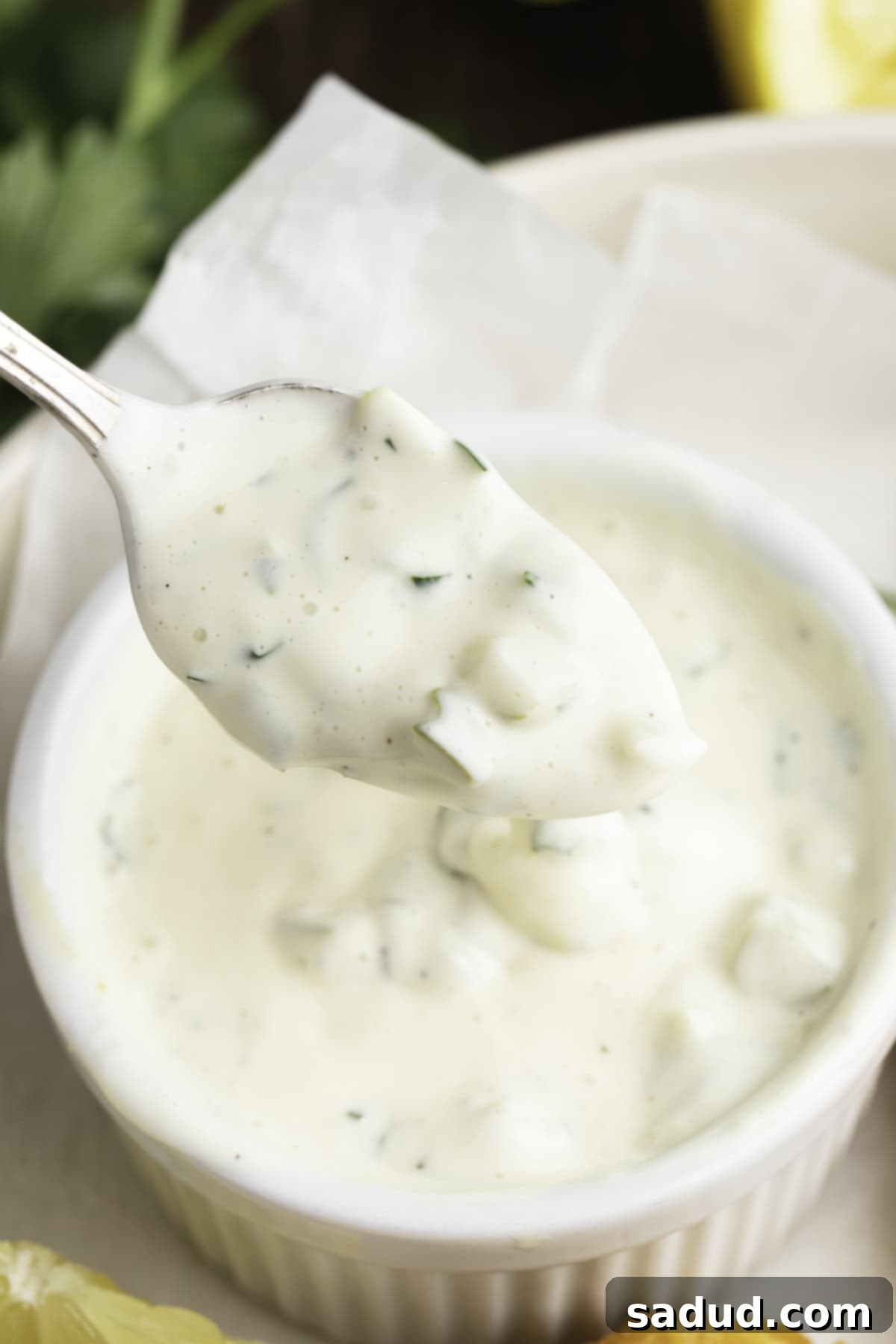The Best Homemade Vegan Tartar Sauce: Creamy, Tangy, and Effortlessly Delicious
Discover the magic of homemade vegan tartar sauce! This incredibly creamy, tangy, and utterly delicious plant-based condiment will revolutionize your meals. Whether you’re serving it alongside crispy vegan “fish” and chips, as a vibrant dip for fresh vegetables, or as a zesty dressing for your favorite salads, this easy-to-follow recipe is destined to become a staple in your kitchen. Say goodbye to bland, store-bought versions and hello to a fresh, flavorful sauce that’s simple to prepare and packed with irresistible taste.

What Makes This Homemade Vegan Tartar Sauce So Good?
Our vegan tartar sauce isn’t just a delicious condiment; it’s a culinary game-changer that stands out for several compelling reasons:
- Unbelievably Easy and Quick: You’ll be amazed at how fast this comes together! With just a handful of pantry staples and about 5 minutes of prep time, you can whip up a batch of this flavorful sauce. There’s no cooking required, making it perfect for busy weeknights or impromptu gatherings. Its simplicity means even beginner cooks can achieve perfect results every time.
- Food-Allergy Friendly for Everyone: This recipe is a dream come true for those with dietary restrictions or allergies. Being completely vegan, it is naturally dairy-free and egg-free, addressing two of the most common allergens. Furthermore, it’s also inherently gluten-free. To make it truly compliant with a wider range of needs, opt for a vegan mayonnaise that is soy-free and nut-free. This thoughtful selection ensures that your homemade vegan tartar sauce can be entirely free of the top 8 allergens, allowing nearly everyone to enjoy its deliciousness without worry.
- Creamy Texture & Vibrant Flavor: The combination of creamy vegan mayo with finely chopped dill pickles, fresh parsley, and a touch of lemon juice creates a rich, smooth sauce with delightful pockets of briny crunch. The balance of tanginess, savory depth, and fresh herbaceous notes is simply divine, elevating any dish it accompanies.
- Incredibly Versatile: While traditionally paired with seafood, this vegan tartar sauce breaks free from conventions. Its robust flavor profile makes it suitable for an astonishing array of dishes, from a simple vegetable dip to a sophisticated salad dressing, a spread for sandwiches, or a topping for grilled plant-based proteins.
- Healthier, Fresher Alternative: Making your own tartar sauce means you control the ingredients, avoiding artificial preservatives, excessive sugars, and unhealthy fats often found in store-bought options. This homemade version offers a fresher, cleaner taste that’s often lighter and more nutritious.
Chef’s Tips for the Perfect Vegan Tartar Sauce
Achieving the ultimate vegan tartar sauce is simple with these expert recommendations:
- Chill for Enhanced Flavor: For the most exquisite flavor, I highly recommend making your tartar sauce in advance and letting it sit in the fridge for at least one to two hours before serving. This crucial chilling period allows the various flavors from the pickles, herbs, and lemon juice to meld beautifully and deepen, creating a more harmonious and pronounced taste experience. While it’s perfectly fine to use it right away if you’re short on time, the patience for chilling will truly be rewarded with a superior sauce.
- Non-Vegan Option: If you’re not strictly adhering to a vegan diet or are serving a mixed crowd, feel free to use regular mayonnaise as the base. The end result will still be a wonderfully creamy and flavorful tartar sauce; it just won’t be suitable for a vegan lifestyle. This flexibility ensures everyone can enjoy a homemade condiment that’s truly delightful.
- Beyond Seafood: Unlock Its Versatility: Tartar sauce is famously served with seafood, but its uses extend far beyond. It excels as a dip for a wide variety of fresh vegetables like carrot sticks, celery, bell pepper slices, and cucumber. It also makes an exceptional, tangy salad dressing, particularly for creamy coleslaws or potato salads. For a truly immersive and satisfying vegan “seafood” dinner, consider pairing your homemade sauce with our acclaimed vegan shrimp, vegan fish fillets, or homemade vegan crabcakes. It also makes a fantastic spread for veggie burgers, sandwiches, or even a dollop on baked potatoes or roasted vegetables.
- Quality Ingredients Matter: Since this recipe uses minimal ingredients, the quality of each component shines through. Use fresh dill pickles for their crisp texture and bright flavor, and fresh parsley for its vibrant, herbaceous notes. A good quality vegan mayonnaise will also make a significant difference in the sauce’s overall creaminess and taste.
- Customization is Key: Don’t hesitate to experiment! For an extra burst of briny flavor, finely chop and add a tablespoon of capers. If you like a hint of spice, a tiny pinch of cayenne pepper or a dash of hot sauce can add a delightful kick. You can also experiment with other fresh herbs like chives or a tiny bit of fresh dill alongside the parsley.

Essential Ingredients and Their Role
Each ingredient in this vegan tartar sauce plays a crucial role in creating its iconic flavor and texture:
- Vegan Mayonnaise: This is the creamy foundation of our sauce. It provides the smooth, rich base that binds all the other ingredients together, giving tartar sauce its signature luscious consistency. Opt for your favorite brand, ensuring it’s free of any allergens you might be avoiding.
- Dill Pickles (Finely Chopped): The star of tartar sauce! Finely chopped dill pickles contribute that essential tangy, briny flavor and delightful crunchy texture. Their acidity is key to cutting through the richness of the mayo and brightening the sauce.
- Fresh Parsley (Chopped): Fresh herbs are non-negotiable for vibrant flavor. Parsley adds a fresh, slightly peppery, and herbaceous note that elevates the sauce and provides a beautiful speckle of green.
- Sugar: A small amount of sugar balances the acidity from the pickles and lemon juice, ensuring a well-rounded flavor profile. (See notes below for vegan and dietary considerations).
- Lemon Juice: Freshly squeezed lemon juice brightens the sauce, adding a zesty, tart kick that is characteristic of classic tartar sauce. It’s a key ingredient for that desirable tang.
- Dijon Mustard: Dijon mustard provides a subtle, pungent, and slightly spicy note that adds depth and complexity to the sauce without overpowering the other flavors.
- Salt and Pepper: These essential seasonings bring all the flavors into harmony, allowing you to adjust to your personal preference for a perfectly seasoned sauce.
Frequently Asked Questions About Vegan Tartar Sauce
Here are answers to some common questions about making and enjoying homemade vegan tartar sauce:
- Can I use sweet relish instead of dill pickles? While traditional tartar sauce often uses dill pickles, you can substitute sweet relish if you prefer a sweeter profile. If you do, you might want to omit or reduce the added sugar in the recipe to avoid an overly sweet sauce.
- How long does homemade vegan tartar sauce last? When stored in an airtight container in the refrigerator, your homemade vegan tartar sauce will stay fresh for about 5-7 days. Always check for any signs of spoilage before consuming.
- Can I freeze vegan tartar sauce? Freezing mayonnaise-based sauces, whether vegan or not, is generally not recommended. The emulsion can break upon thawing, resulting in a separated, oily, and unappealing texture. It’s best enjoyed fresh and stored in the fridge.
- What if I don’t have fresh lemon juice? Fresh lemon juice offers the best flavor, but if you’re in a pinch, you can use bottled lemon juice, lime juice, or even a small amount of apple cider vinegar to provide that essential acidity. Adjust to taste.
- Can I add other ingredients? Absolutely! Consider adding finely chopped chives, a pinch of smoked paprika for depth, a dash of hot sauce for heat, or even finely minced shallots for a more gourmet touch.
Other Delicious Vegan Recipes You’ll Love
- Crispy Vegan Latkes
- Easy Vegan Tofu Cream Cheese (4 Flavors)
- Homemade Vegan BBQ Sauce
- Easy 10-Minute Vegan Garlic Bread
- The Best Vegan Alfredo Sauce
- Flavorful Chickpea Salad Sandwich
If you loved this recipe as much as we did, don’t forget to leave us a review below. ★ Follow Easy Healthy Recipes on Pinterest, Facebook, and Instagram, too!
For more delicious recipes, visit our sister sites, 40 Aprons and Easy Cheap Recipes.

Vegan Tartar Sauce
 Cheryl Malik
Cheryl Malik
Print
SaveSaved!
Ingredients
- ½ cup vegan mayo
- ½ cup dill pickles finely chopped, for optimal texture and flavor
- 1 tablespoon fresh parsley chopped, for freshness and color
- ½ teaspoon sugar see Notes for vegan and dietary considerations
- 1 teaspoon lemon juice freshly squeezed for best results
- 1 teaspoon dijon mustard
- salt to taste, balances flavors
- pepper freshly ground, to taste
Equipment
-
1 medium bowl
-
1 large spoon or spatula
Instructions
-
In a medium-sized mixing bowl, combine the vegan mayo, finely chopped dill pickles, fresh chopped parsley, sugar, lemon juice, dijon mustard, and season with salt and pepper to taste. Stir all ingredients thoroughly until they are fully combined and the sauce is smooth and consistent. For best flavor, cover the bowl and chill in the refrigerator for 1-2 hours before serving. Alternatively, if time is short, you can serve it immediately.
Notes
- Vegan Sugar Check: Be aware that some refined white sugar is processed using bone char, which is not vegan-friendly. Always double-check your sugar packaging or opt for certified organic or unrefined sugars to ensure it’s 100% compatible with a vegan diet. Alternatively, you can omit the sugar entirely for a less sweet, more tangy sauce.
- Make it Keto-Friendly: To adapt this recipe for a ketogenic diet, simply replace the granulated sugar with a keto-approved sweetener like Swerve, stevia, or monk fruit. You can also skip the sugar altogether if you prefer a sharper, more savory flavor profile.
- Make it Whole30 Compliant: For a Whole30 version, ensure you skip the sugar entirely. Additionally, select a compliant vegan mayonnaise that is made with Whole30-approved ingredients (such as avocado oil) and a dijon mustard that contains no added sugar or sulfites.
- Storage: Store leftover vegan tartar sauce in an airtight container in the refrigerator for up to 5-7 days. It’s not recommended to freeze it, as the mayo emulsion may separate.
- Serving Temperature: While delicious immediately, chilling the sauce allows the flavors to deepen and meld, resulting in a more harmonious and robust taste.
Nutrition Information
Number of total servings shown is approximate. Actual number of servings will depend on your preferred portion sizes.
Nutritional values shown are general guidelines and reflect information for 1 serving using the ingredients listed, not including any optional ingredients. Actual macros may vary slightly depending on specific brands and types of ingredients used.
To determine the weight of one serving, prepare the recipe as instructed. Weigh the finished recipe, then divide the weight of the finished recipe (not including the weight of the container the food is in) by the desired number of servings. Result will be the weight of one serving.
